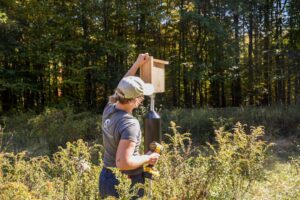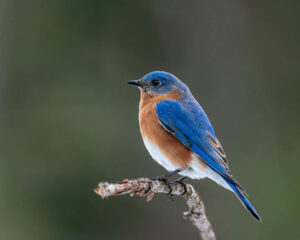By Georgia Albanese, Landscape Gardener, New England Botanic Garden
February 2024
Throughout your visit to the New England Botanic Garden, you will notice a myriad of birds overlooking the woodlands, swooping through the meadows, and chirping in the gardens. These birds are valued friends of the Garden, as they contribute to the overall diversity of the ecosystem, keeping environmental cycles intact. As part of the Garden’s land stewardship team and someone passionate about conservation, I was given an ongoing project to support a specific population of birds in our area, and with it have broadened my knowledge of wildlife conservation.
The eastern bluebird (Sialia sialis) is a common New England bird species, its range extending throughout the entire eastern side of the country and parts of the Midwest. While their current conservation status is strong, bluebirds were threatened from the 1920’s to the 1970’s. This decline can be chalked up to a variety of reasons, such as toxic pesticide use and habitat decline at the time, but the most prominent one was displacement by non-native introduced species such as the house sparrow (Passer domesticus) and European starling (Sturnus vulgaris). These bird species share similar habitat patterns with the eastern bluebird—they’re all cavity nesters. To be a cavity nester means to prefer building habitat in a provided hollowed out location, like a dead tree, as opposed to nesting atop the tree canopy. Bluebirds are at a disadvantage when searching for nesting habitat due to the aggressive nature of sparrows and starlings, who will outcompete the native bluebirds for the best cavities to nest within. While some bluebird populations migrate south in the colder months, many call New England home all year round, which makes finding a warm, safe nesting site much more crucial.

Georgia Albanese installs a bluebird box fall of 2023. Photo by Megan Stouffer/New England Botanic Garden.
This past fall, my colleague Robert Graham and I installed specialized birdboxes throughout the Garden’s meadows to give our eastern bluebirds a safe place to nest, counteracting competition and providing for overwintering broods. Once I researched the best birdbox methods and mapped ideal locations on the property, we placed 20 birdboxes throughout 20 acres of the Garden’s meadowland. Since bluebirds spend most of their time in open, grassy spaces, our meadows make the perfect site for nesting. The birdboxes are in pairs, and each pair is spaced at least 350 feet apart from one another and 50 feet from the tree line. The reason that the birdboxes are arranged in pairs is to prevent bluebird-to-bluebird competition, and to potentially attract other positively coexisting species to the neighboring boxes, such as the tree swallow (Tachycineta bicolor), who can protect the bluebirds by fending off introduced species with aggressive behaviors.
Those who have tried their hand at upkeeping birdboxes may be aware of the common issue of pest break-ins. Mice, squirrels, wasps, or the previously mentioned non-native birds can overtake a box or even an existing nest. To deter pests and competitors, we installed predator baffles on each of the poles underneath the birdboxes. The baffles are made of a slippery, wobbly metal that will prohibit entry from unwanted visitors. Warding off flying pests may require further management, but these baffles will make a world of difference preventing critters from crawling up the poles and invading the boxes.

Installing boxes in pairs helps discourage competition between bluebirds. Photo by Megan Stouffer/New England Botanic Garden.
Beginning in early March, the boxes will be monitored weekly by a volunteer or myself. Our land stewardship crew will be keeping tabs on the progression of the boxes, including nest development, pest problems, box damage, etc. Monitoring the birdboxes is an important part of hosting these habitats onsite as it ensures that the aimed species will ultimately be the tenant of the box. Moreover, monitoring is critical to our conservation goals as it helps us to better understand changes in wildlife patterns or environmental shifts, as the environment around us continues to change as well. It is our duty as land stewards, gardeners, and nature lovers to support our beneficial cavity nesters through the use and correct management of birdboxes.
Installing bluebird boxes is just the beginning of our wildlife conservation efforts here at the Garden. There are plans for later in the year to install birdboxes for various species, like wood ducks, owls, and even bats, all throughout the property. Land stewardship is a notable value of the New England Botanic Garden, as over half of the property consists of natural habitat. It’s our hope that the conservation efforts we carry out at the Garden will inspire you to do the same, whether it’s planting native plants, turning your grass to meadow, or adding a birdbox to your land.
About the Author
Georgia Albanese was a Landscape Gardener at New England Botanic Garden at Tower Hill from 2023 to 2025. She was mainly responsible for regular groundskeeping of the property as well as executing various conservation projects within the Garden’s natural spaces. Georgia holds a B.S. of Environmental Conservation and Sustainability from the University of New Hampshire; her professional interests include restoration ecology, pollinator conservation, and sustainable systems.

